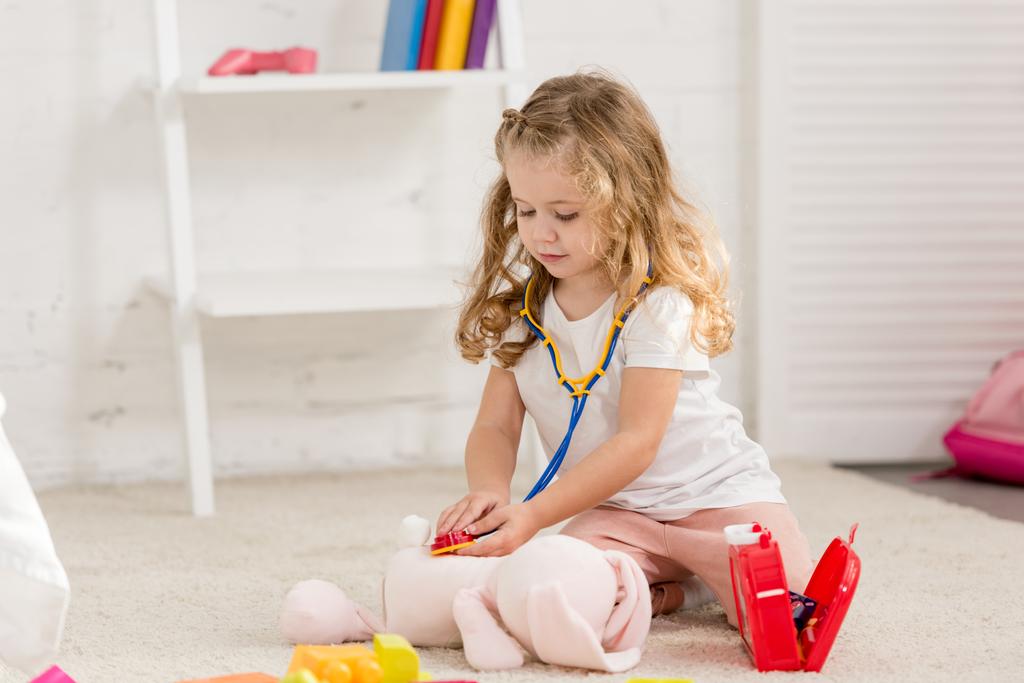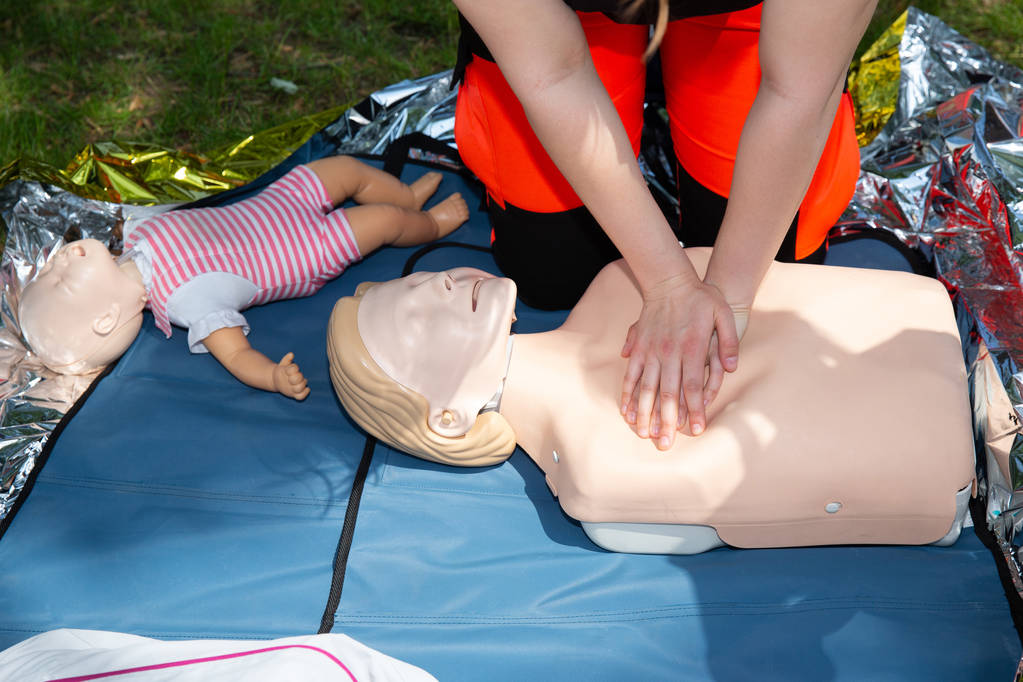Discover effective strategies and tips for teaching basic first aid to 8-9 year old children.
Teaching Basic First Aid to 8-9 Year Old Children
Teaching basic first aid to 8-9 year old children is not only important but also a fun and engaging way to empower them with life-saving skills. In this article, we will explore the importance of first aid for children, essential first aid skills for this age group, and overcome challenges in teaching first aid to children. We will also discuss how to make first aid education interactive and evaluate its effectiveness.

Understanding the Importance of First Aid for Children
First aid plays a crucial role in ensuring the safety of children in various situations. Whether they are at home, school, or outdoors, accidents can happen at any time. By equipping them with first aid knowledge, we empower children to react quickly and appropriately, potentially minimizing the severity of injuries and even saving lives.
Imagine a scenario where a child is playing in the park and suddenly falls off the swing, injuring their arm. Without the knowledge of first aid, they might panic and not know what to do. However, if they have been taught basic first aid skills, they would know to assess the situation, apply pressure to stop any bleeding, and immobilize the injured arm until help arrives. This quick thinking and action can make a significant difference in the outcome of the injury.
First aid is not just about treating physical injuries. It also includes knowledge of how to respond to other emergencies, such as choking or allergic reactions. These situations can be life-threatening, and having the ability to administer first aid can be the difference between life and death.
The Role of First Aid in Safety
First aid is the first line of defense when it comes to safety. It helps children understand how to stay safe and respond in emergencies. By knowing what to do during a crisis, they develop confidence and become more independent. First aid enables them to take immediate action while waiting for professional help to arrive.
Furthermore, first aid education teaches children to assess potential hazards in their surroundings. They learn to identify potential dangers and take preventive measures to avoid accidents. This proactive approach to safety instills a sense of responsibility and empowers children to make informed decisions when faced with risky situations.
Moreover, first aid training also includes teaching children about the importance of communication during emergencies. They learn how to call for help, provide accurate information to emergency services, and stay calm in stressful situations. These communication skills are not only essential during emergencies but also in their everyday lives, helping them become effective communicators and problem solvers.
Benefits of Early First Aid Education
Starting first aid education at a young age yields numerous benefits. Children absorb information like sponges and can quickly grasp vital concepts. Early education builds a solid foundation for lifelong learning and instills a sense of responsibility towards others. By teaching children first aid, we shape them into responsible and caring individuals.
Moreover, early first aid education promotes empathy and compassion. Children learn to understand the pain and suffering of others and develop a desire to help. This empathy extends beyond emergencies and translates into everyday interactions, fostering a kind and supportive community.
Additionally, first aid education equips children with problem-solving skills. They learn to think critically and make quick decisions under pressure. These skills are transferable to various aspects of their lives, including academics, sports, and personal relationships.
By investing in early first aid education, we are not only preparing children for emergencies but also empowering them with life skills that will benefit them throughout their lives. They become confident, responsible, and compassionate individuals who are ready to make a positive difference in the world.
Essential First Aid Skills for 8-9 Year Olds
At the age of 8-9, children are eager learners and capable of acquiring essential first aid skills. Let’s explore some of these skills:
Basic Wound Care
Teaching children how to clean and dress minor wounds is vital. By explaining the importance of keeping wounds clean to prevent infection, they learn proper techniques for cleaning wounds and applying bandages. Using interactive demonstrations and step-by-step guidance, children will develop confidence in taking care of basic injuries.
During these interactive demonstrations, children will have the opportunity to practice cleaning wounds using sterile saline solution and antiseptic wipes. They will also learn how to properly apply adhesive bandages and gauze pads to cover the wound. Through hands-on activities, they will gain a deeper understanding of the importance of wound care and the impact it can have on the healing process.
Recognizing and Responding to Choking
Choking is a common emergency that children should know how to handle. By teaching them the signs of choking and the Heimlich maneuver, children are equipped to assist themselves or others in choking situations. Through interactive scenarios and role-playing, children will be empowered to take prompt action in these critical moments.
During these interactive scenarios, children will learn to identify the signs of choking, such as difficulty breathing, clutching the throat, and making high-pitched sounds. They will then practice the Heimlich maneuver on mannequins, using proper hand placement and technique. By simulating real-life situations, children will develop the skills and confidence needed to respond effectively in choking emergencies.
Dealing with Burns and Scalds
Children often encounter situations where they may burn or scald themselves. Teaching them how to respond to burns and scalds is crucial. By explaining the importance of cooling the burn with water and seeking medical help when necessary, children become informed and responsive. Engaging them in hands-on activities and storytelling can make this learning experience more enjoyable.
During these hands-on activities, children will learn the importance of immediately cooling a burn with cold running water for at least 10 minutes. They will also understand the significance of not applying ice or butter to the burn, as it can worsen the injury. Through storytelling, children will hear real-life accounts of burn incidents and how proper first aid measures helped in the healing process. This will reinforce the importance of their role in providing immediate care for burns and scalds.
By expanding their knowledge and skills in first aid, 8-9 year olds become valuable assets in emergency situations. They gain the confidence to take action and make a difference when someone is injured or in need of assistance. These essential first aid skills will stay with them throughout their lives, empowering them to be responsible and compassionate individuals.
Making First Aid Engaging for Young Learners
It’s important to make first aid education a fun and engaging experience for young learners. By using interactive teaching techniques and incorporating first aid into play, children will be more excited about learning these life-saving skills.

Interactive Teaching Techniques
Engaging children through interactive teaching techniques helps capture their attention and ensures better retention of information. Incorporate hands-on activities, visual aids, and group discussions to make the learning experience more immersive.
One effective interactive teaching technique is organizing a first aid treasure hunt. This activity involves hiding first aid-related items around the learning area and providing children with clues to find them. As they search for the items, they will learn about different first aid tools and their uses. This hands-on approach not only makes learning fun but also allows children to actively participate in the learning process.
Another interactive technique is creating a first aid poster. Divide children into small groups and assign each group a specific first aid topic, such as CPR or treating burns. Provide them with art supplies and encourage them to design a poster that educates others about their assigned topic. This activity not only enhances their creativity but also reinforces their understanding of first aid concepts.
Incorporating First Aid into Play
Children learn best through play, and incorporating first aid into their playtime can be highly effective. By integrating first aid scenarios into their imaginative play, children can practice and reinforce their knowledge of life-saving skills.
Encourage children to role-play different emergency scenarios. Provide them with costumes, props, and a designated play area where they can act out various first aid situations. For example, they can pretend to be paramedics responding to a car accident or doctors treating a patient with a broken bone. This type of play allows children to apply their first aid knowledge in a realistic and engaging way.
Another way to incorporate first aid into play is by providing children with toy first aid kits. These kits can include bandages, pretend medications, and other basic first aid supplies. Encourage children to use these kits to treat their dolls or stuffed animals when they pretend they are injured or sick. This hands-on practice helps children develop confidence in their ability to provide first aid and reinforces the importance of these skills.
In conclusion, making first aid engaging for young learners involves using interactive teaching techniques and incorporating first aid into play. By incorporating hands-on activities, visual aids, group discussions, and imaginative play, children will not only have fun but also develop a solid foundation in life-saving skills.
Overcoming Challenges in Teaching First Aid to Children
Teaching first aid to children can be challenging, but with the right approach, it can be overcome.
Addressing Children’s Fears about First Aid
Some children may feel anxious or fearful when learning about first aid. It is essential to address their fears and provide reassurance. Explain that first aid is about helping others and that they are learning these skills to make a positive impact. Incorporate storytelling and emphasize the heroic aspect of first aid to inspire them and alleviate their fears.
Simplifying Complex First Aid Concepts
Children may find certain first aid concepts complex or overwhelming. Breaking down complex information into simple and easy-to-understand terms is crucial. Use visual aids, props, and age-appropriate language to explain concepts. Incorporate repetition and reinforcement to ensure children grasp the important concepts and feel confident in their abilities.
Evaluating the Effectiveness of First Aid Education
To ensure the effectiveness of first aid education, we need to evaluate children’s understanding of first aid and reinforce their knowledge over time.
Assessing Children’s Understanding of First Aid
Regular assessments can help gauge children’s understanding of first aid concepts and identify areas that need improvement. Utilize quizzes, hands-on practical assessments, and scenario-based questions to evaluate their knowledge and skills. Providing constructive feedback and addressing any gaps will help children develop a deeper understanding of first aid.
Reinforcing First Aid Knowledge Over Time
Repetition and reinforcement are key to ensuring that children retain their first aid knowledge. Incorporate first aid practice sessions into regular routines and encourage discussions about first aid in everyday life. Consider organizing refresher courses or workshops periodically to reinforce and expand upon their existing knowledge.
In conclusion, teaching basic first aid to 8-9 year old children can be exciting and rewarding. By understanding the importance of first aid, teaching essential skills, making it engaging, and overcoming challenges, we can empower children with life-saving knowledge. By evaluating their understanding and reinforcing their knowledge over time, we ensure that they can confidently handle emergencies and make a difference in their communities. Let’s embark on this journey of first aid education together!



